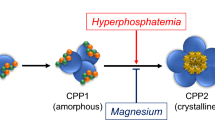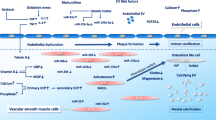Abstract
The present study evaluated the role of oxidative stress on α2-adrenoceptor-mediated events (Cl−/HCO −3 exchanger activity and cAMP accumulation) in immortalized renal proximal tubular epithelial (PTE) cells from the spontaneously hypertensive rat (SHR) and its normotensive control (Wistar Kyoto rat; WKY). The exposure of cells to α2-adrenoceptor agonist UK 14,304 reduced Cl−/HCO −3 exchanger activity with EC50 of 2.0 μM in SHR PTE cells, whereas in WKY PTE cells no effects were observed. These effects were abolished by yohimbine, an α2-adrenoceptor antagonist, but insensitive to prazosin. Both forskolin and dibutyryl cAMP stimulated Cl−/HCO −3 exchanger activity in WKY and SHR PTE cells, which was prevented by the PKA inhibitor H-89. Forskolin increased cAMP levels in both WKY and SHR PTE cells to a similar extent, but UK 14,304 significantly reduced the forskolin-induced increase in cAMP levels in only SHR PTE cells. Immunoblotting showed that expression of α2B-adrenoceptors was 12-times greater in SHR PTE cells than in WKY PTE cells. SHR PTE cells have increased levels of H2O2 and overexpress type 2 NADPH oxidase (NOX2) and p22phox compared with WKY cells. In SHR PTE cells, the NADPH oxidase inhibitor apocynin reduced their increased ability to generate H2O2 and abolished the inhibitory effects of UK 14,304 on Cl−/HCO −3 exchanger activity and cAMP accumulation. It is concluded that differences between WKY and SHR PTE cells on their sensitivity to α2-adrenoceptor agonists correlate with the expression of α2B-adrenoceptors. The increased generation of H2O2 amplifies the response downstream to α2-adrenoceptor activation in SHR PTE cells.









Similar content being viewed by others
References
Guyton AC, Coleman TG, Cowley AV Jr, Scheel KW, Manning RD Jr, Norman RA Jr (1972) Arterial pressure regulation. Overriding dominance of the kidneys in long-term regulation and in hypertension. Am J Med 52:584–594. doi:10.1016/0002-9343(72)90050-2
DiBona GF (2005) Physiology in perspective: the wisdom of the body. Neural control of the kidney. Am J Physiol Regul Integr Comp Physiol 289:R633–R641
Kanagy NL (2005) Alpha2-adrenergic receptor signalling in hypertension. Clin Sci (Lond) 109:431–437
Gesek FA (1999) Alpha1-and alpha2-adrenoceptor control of sodium transport reverses in developing hypertension. Hypertension 33:524–529
Rossier BC, Palmer LG (1992) Mechanisms of aldosterone action on sodium and potassium transport. In: Seldin DW (ed) The kidney, physiology and pathophysiology. Raven Press Publishers, New York, pp 1373–1409
Verrey F (1995) Transcriptional control of sodium transport in tight epithelial by adrenal steroids. J Membr Biol 144:93–110
Aronson PS, Giebisch G (1997) Mechanisms of chloride transport in the proximal tubule. Am J Physiol Renal Physiol 273:F179-F192
Dart C, Vaughan-Jones RD (1992) Na+–HCO −3 symport in the sheep cardiac Purkinje fibre. J Physiol 451:365–385
Gomes P, Vieira-Coelho MA, Soares-Da-Silva P (2001) Ouabain-insensitive acidification by dopamine in renal OK cells: primary control of the Na+/H+ exchanger. Am J Physiol Regul Integr Comp Physiol 281:R10-R18
Lazdunski M, Frelin C, Vigne P (1985) The sodium/hydrogen exchange system in cardiac cells: its biochemical and pharmacological properties and its role in regulating internal concentrations of sodium and internal pH. J Mol Cell Cardiol 17:1029–1042
Xu P, Spitzer KW (1994) Na-independent Cl−HCO −3 exchange mediates recovery of pHi from alkalosis in guinea pig ventricular myocytes. Am J Physiol 267:H85–H91
Krapf R, Alpern RJ (1993) Cell pH and transepithelial H/HCO3 transport in the renal proximal tubule. J Membr Biol 131:1–10
Soleimani M, Singh G (1995) Physiologic and molecular aspects of the Na+/H+ exchangers in health and disease processes. J Investig Med 43:419–430
Alpern RJ (1990) Cell mechanisms of proximal tubule acidification. Physiol Rev 70:79–114
Hara C, Satoh H, Usui T, Kunimi M, Noiri E, Tsukamoto K, Taniguchi S, Uwatoko S, Goto A, Racusen LC, Inatomi J, Endou H, Fujita T, Seki G (2000) Intracellular pH regulatory mechanism in a human renal proximal cell line (HKC-8): evidence for Na+/H+ exchanger, CI−/HCO −3 exchanger and Na+–HCO −3 cotransporter. Pflugers Arch 440:713–20
Petrovic S, Ma L, Wang Z, Soleimani M (2003) Identification of an apical Cl−/HCO −3 exchanger in rat kidney proximal tubule. Am J Physiol Cell Physiol 285:C608-C617
Soleimani M, Burnham CE (2000) Physiologic and molecular aspects of the Na+:HCO −3 cotransporter in health and disease processes. Kidney Int 57:371–384
Pedrosa R, Jose PA, Soares-da-Silva P (2004) Defective D1-like receptor-mediated inhibition of the Cl−/HCO −3 exchanger in immortalized SHR proximal tubular epithelial cells. Am J Physiol Renal Physiol 286:F1120–F1126
Makino A, Skelton MM, Zou AP, Cowley AW Jr (2003) Increased renal medullary H2O2 leads to hypertension. Hypertension 42:25–30
Minuz P, Patrignani P, Gaino S, Degan M, Menapace L, Tommasoli R, Seta F, Capone ML, Tacconelli S, Palatresi S, Bencini C, Del Vecchio C, Mansueto G, Arosio E, Santonastaso CL, Lechi A, Morganti A, Patrono C (2002) Increased oxidative stress and platelet activation in patients with hypertension and renovascular disease. Circulation 106:2800–2805
Schnackenberg CG, Welch WJ, Wilcox CS (1998) Normalization of blood pressure and renal vascular resistance in SHR with a membrane-permeable superoxide dismutase mimetic: role of nitric oxide. Hypertension 32:59–64
Vaziri ND, Ni Z, Oveisi F, Trnavsky-Hobbs DL (2000) Effect of antioxidant therapy on blood pressure and NO synthase expression in hypertensive rats. Hypertension 36:957–964
Adler S, Huang H (2004) Oxidant stress in kidneys of spontaneously hypertensive rats involves both oxidase overexpression and loss of extracellular superoxide dismutase. Am J Physiol Renal Physiol 287:F907–F913
de Cavanagh EM, Toblli JE, Ferder L, Piotrkowski B, Stella I, Inserra F (2006) Renal mitochondrial dysfunction in spontaneously hypertensive rats is attenuated by losartan but not by amlodipine. Am J Physiol Regul Integr Comp Physiol 290:R1616–R1625
Sullivan JC, Sasser JM, Pollock JS (2006) Sexual Dimorphism in oxidant status in spontaneously hypertensive rats. Am J Physiol Regul Integr Comp Physiol 292:R764–R768
Woost PG, Orosz DE, Jin W, Frisa PS, Jacobberger JW, Douglas JG, Hopfer U (1996) Immortalization and characterization of proximal tubule cells derived from kidneys of spontaneously hypertensive and normotensive rats. Kidney Int 50:125–134
Gomes P, Soares-da-Silva P (2002) Na+/H+ exchanger activity and dopamine D1-like receptor function in two opossum kidney cell clonal sublines. Cell Physiol Biochem 12:259–268
Thomas JA, Buchsbaum RN, Zimniak A, Racker E (1979) Intracellular pH measurements in Ehrlich ascites tumor cells utilizing spectroscopic probes generated in situ. Biochemistry 18:2210–2218
Fraga S, Luo Y, Jose P, Zandi-Nejad K, Mount DB, Soares-da-Silva P (2006) Dopamine D1-like receptor-mediated inhibition of Cl/HCO −3 exchanger activity in rat intestinal epithelial IEC-6 cells is regulated by G protein-coupled receptor kinase 6 (GRK 6). Cell Physiol Biochem 18:347–360
Yingst DR, Massey KJ, Rossi NF, Mohanty MJ, Mattingly RR (2004) Angiotensin II directly stimulates activity and alters the phosphorylation of Na–K-ATPase in rat proximal tubule with a rapid time course. Am J Physiol Renal Physiol 287:F713–F721
Gesek FA, Schoolwerth AC (1990) Hormonal interactions with the proximal Na+–H+ exchanger. Am J Physiol 258:F514–F521
Gesek FA, Strandhoy JW (1990) Dual interactions between alpha2-adrenoceptor agonists and the proximal Na+–H+ exchanger. Am J Physiol 258:F636–F642
Bedard K, Krause KH (2007) The NOX family of ROS-generating NADPH oxidases: physiology and pathophysiology. Physiol Rev 87:245–313
Anand-Srivastava MB (1993) Platelets from spontaneously hypertensive rats exhibit decreased expression of inhibitory guanine nucleotide regulatory protein. Relation with adenylyl cyclase activity. Circ Res 73:1032–1039
Brodde OE, Michel MC (1992) Adrenergic receptors and their signal transduction mechanisms in hypertension. J Hypertens Suppl 10:S133–S145
Khalid M, Ilhami N, Giudicelli Y, Dausse JP (2002) Testosterone dependence of salt-induced hypertension in Sabra rats and role of renal alpha2-adrenoceptor subtypes. J Pharmacol Exp Ther 300:43–49
Stanko CK, Smyth DD (1991) Proximal tubular alpha 2-adrenoceptor density in the spontaneously hypertensive rat. Am J Hypertens 4:64–67
Umemura S, Marver D, Smyth DD, Pettinger WA (1985) Alpha2-adrenoceptors and cellular cAMP levels in single nephron segments from the rat. Am J Physiol Renal Fluid Electrolyte Physiol 249:F28–F33
Murphy TJ, Bylund DB (1988) Characterization of alpha2-adrenergic receptors in the OK cell, an opossum kidney cell line. J Pharmacol Exp Ther 244:571–578
Asghar M, Banday AA, Fardoun RZ, Lokhandwala MF (2006) Hydrogen peroxide causes uncoupling of dopamine D1-like receptors from G proteins via a mechanism involving protein kinase C and G-protein-coupled receptor kinase 2. Free Radic Biol Med 40:13–20
Chabrashvili T, Tojo A, Onozato ML, Kitiyakara C, Quinn MT, Fujita T, Welch WJ, Wilcox CS (2002) Expression and cellular localization of classic NADPH oxidase subunits in the spontaneously hypertensive rat kidney. Hypertension 39:269–274
Zhan CD, Sindhu RK, Vaziri ND (2004) Up-regulation of kidney NAD(P)H oxidase and calcineurin in SHR: reversal by lifelong antioxidant supplementation. Kidney Int 65:219–227
Acknowledgments
This study is supported by Fundação para a Ciência e a Tecnologia, POCI, FEDER and Programa Comunitário de Apoio (POCI/SAU-FCF/59207/2004).
Author information
Authors and Affiliations
Corresponding author
Rights and permissions
About this article
Cite this article
Simão, S., Fraga, S., Jose, P.A. et al. Oxidative stress plays a permissive role in α2-adrenoceptor-mediated events in immortalized SHR proximal tubular epithelial cells. Mol Cell Biochem 315, 31–39 (2008). https://doi.org/10.1007/s11010-008-9785-6
Received:
Accepted:
Published:
Issue Date:
DOI: https://doi.org/10.1007/s11010-008-9785-6




